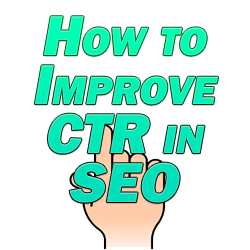One of the most underestimated factors in ranking relates to how to improve CTR in SEO. In other words, garnering more clicks in Google’s SERPs (search engine results pages) not only brings in more traffic, but it can also boost your rankings.
Why does knowing how to improve CTR in SEO improve your rankings? As good as Google’s algorithm is, it still relies heavily on user interactions to gauge how effectively a page relates to the keyword it’s ranking for. The basic idea is that if two similarly ranking pages for the same keyword are getting vastly different click-through rates, Google believes that the one garnering more clicks is more relevant for the user to the search (which makes sense).
Common sense dictates that a page which is outperforming (in terms of clicks) better ranking pages should be ranking higher.
Now that we understand this context, the obvious question is how to improve CTR in SEO?
How to Improve CTR SEO
In the SERPs, all we have to work with are three elements: the title, description, and URL.
These are the three things which appear in a typical Google organic search listing. Now let’s talk about how to optimize them with my 4 foolproof tips on how to improve CTR in SEO.
1 – Realize the Mindset Behind the Keyword
Really all SEO (after keyword selection) should begin with identifying the mindset behind the keyword.
Let’s consider an example: “how to calm a screaming baby”.
If someone typed that into Google, think about where they’re coming from. They are possibly in a stressful situation in that very moment of wanting to calm and quiet a young child.
As such, both our page’s title and description in Google should completely reassure that person that if they click on our listing, they will receive the child care tips which will not just bring that baby relief.
But it’s not just about bringing the baby relief, it’s about bringing the caregiver relief, as well.
And not just relief, but INSTANT relief.
We have to assure the person using Google of all of these things as succinctly as possible. We can do this by putting ourselves in the mindset of the person doing the searching.
Remember that everyone using Google is looking for a resolution of some sort. Identify what that resolution is, then ask yourself what listing you’d click-through on in that spot and there’s what you write.
2 – Clickbait is Your Friend (If You Can Deliver)
Everyone hates clickbait because it typically succeeds in grabbing attention.
This leads me to this next point, or don’t be afraid to go BIG with your title. Use superlatives (the BEST cure for…) to catch your viewer’s eye. It’s just a means to an end – getting that click-through to your page.
Just make sure that you can back up whatever impressive claims you made in your listing on the page itself, otherwise they’ll leave as quickly as they got there.
Also remember that some titles never go out of style.
Numbered lists (5 ways to…, 10 secrets to…, etc.) establish expectations and pique curiosity.
See my tips on how to write a great title for more examples.
3 – Descriptions Are For Closers
The title is for selling. You’ve caught someone’s eye with your eye popping clickbait title. For many people and depending on your title, that will be enough to earn a click.
For those who are still on the fence, your call to action can put them over the edge.
My call to action on this article? “Use these 4 foolproof tips…”
I’m telling the person to click-through so that they access the tips I’m offering to get a better CTR (yes, I note the irony).
Utilize this space to fill in any gaps you couldn’t convey in the title; anything you can think of to sweeten the deal of encouraging that click.
4 – Be Better Than Your Peers
I’m about to paraphrase/kill that old joke now: “How do you outrun a bear in the wild? Be faster than whoever you’re with.”
Jokes aside, this is actually pretty relevant in how to improve your CTR in SEO. You don’t have to have the greatest listing ever written/seen in Google. You just have to be more persuasive than your competition.
Take a look at your competition in terms of the top 10 pages ranking for the keyword you’re targeting.
Note their titles and descriptions. Decide what’s working for each of those and more importantly what could be improved to encourage a click.
Amazingly, many webmasters still neglect specifying a description. Ironically they do this while sweating other ranking factors like backlinks (see how to build backlinks for SEO).
In these cases, Google is left to automatically create one from the content of the page which oftentimes isn’t even relevant to the keyword. In this case, just by making a custom title and description for your page, you’re leagues ahead of many competitors.
Regardless of the competition, begin putting a lot more emphasis on and thought into your meta title and description and you’ll see your clicks skyrocket and with it your ranking position.
